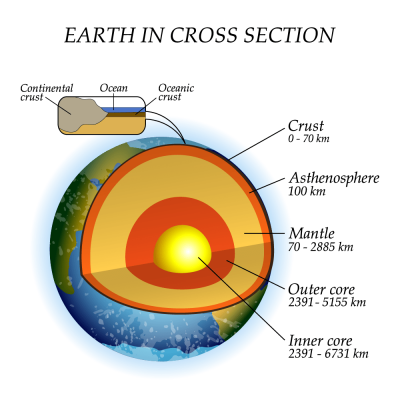
Planet Earth is made up of a number of different layers. Some of these are solid, while others are liquid or a mixture of both. Knowing about Earth’s structure will help you understand what is happening on the surface- where you live.
Water
Seas and oceans cover about 71 per sent of Earth’s surface.
Land
Just 29 percent of Earth surface is land, which is split up into continents.
Inside and outside
Ocean and land cover Earth’s surface, but inside are many complex layers.
Crust
The crust is the thinnest layer of the Earth and is the layer we live on. It is made up of a variety of rocks and can reach up to 70 km thick in places. The crust itself is divided into large chunks called tectonic plates. There are around 7 large and 12 small plates, which ‘float’ on top of the mantle beneath them. The plates themselves are made up of 2 different types of crust, continental crust under the land and oceanic crust under the sea. Continental crust is thick (25-70 km) and light because it is made of rocks with a low density. Oceanic crust is thin (6-11 km) and heavy because it is made of rocks (mostly volcanic rocks) that have a high density. The oceanic crust covers 2/3 of the Earth’s surface.
Continental crust
Mixtures of different rocks are found in this layer, which forms all of the land found on Earth. The continental crust is older than the oceanic crust. As with oceanic crust, continental crust is created by plate tectonics. At convergent plate boundaries, where tectonic plate’s crash into each other, continental crust is thrust up in the process of orogeny, or mountain-building. For this reason, the thickest parts of continental crust are at the world’s tallest mountain ranges. Like icebergs, the tall peaks of the Himalayas and the Andes are only part of the region’s continental crust—the crust extends unevenly below the Earth as well as soaring into the atmosphere.
Oceanic crust
This rocky layer under the Earth’s seas and oceans is constantly changing, as tectonic plates move around and liquid rock, or magma, rises up from the asthenosphere, then cools and hardens.
Oceanic crust is about 6 km (4 miles) thick. It is composed of several layers, not including the overlying sediment. The topmost layer, about 500 metres (1,650 feet) thick, includes lavas made of basalt (that is, rock material consisting largely of plagioclase [feldspar] and pyroxene). Oceanic crust differs from continental crust in several ways: it is thinner, denser, younger, and of different chemical composition. Like continental crust, however, oceanic crust is destroyed in subduction zones.
Mantle
The mantle is the thickest layer of the Earth at 2,900 km thick. It makes up nearly 80% of the volume of the Earth. The mantle itself is divided into 2 layers, the upper and lower mantles and the heat within these layers drives convection currents.
Lower mantle
The layer of solid rock reaches temperatures of up to 3,000°C(5,432°F). This is hot enough to melt the rock, but pressure pushing down prevents this.
The lower mantle is the lower liquid portion of the mantle ranging from 400 miles below the surface to about 1,800 miles below the surface. The lower mantle is incredibly large and takes up most of the volume of the earth. Being so deep inside the earth, the temperature and pressure of the lower mantle are extremely high. Temperatures can soar to over 7,000 degrees Fahrenheit at the bottom edge of the lower mantle, near the core. Pressure in the lower mantle is a maximum of 1.3 million times that of the surface, creating minerals we normally would not see in the crust.
Upper mantle
The upper mantle begins just beneath the crust and ends at the lower mantle. The thickness of the upper mantle is between 200 and 250 miles. The entire mantle is about 1800 miles thick, which means the lower mantle makes up the bulk of this part of the Earth. The temperature of the mantle near the crust ranges from 900 to 1600 degrees Fahrenheit. It gets hotter at greater depths. The lower mantle near the core is as hot as 7000 degrees Fahrenheit.
This layer is made of both solid and liquid rock. It is constantly moving, which is why the tectonic plates that form Earth’s crust also move around on top of it.
Outer core
The outer core, about 2,200 kilometers (1,367 miles) thick, is mostly composed of liquid iron and nickel. The NiFe alloy of the outer core is very hot, between 4,500° and 5,500° Celsius (8,132° and 9,932° Fahrenheit).
The liquid metal of the outer core has very low viscosity, meaning it is easily deformed and malleable. It is the site of violent convection. The churning metal of the outer core creates and sustains Earth’s magnetic field.
The hottest part of the core is actually the Bullen discontinuity, where temperatures reach 6,000° Celsius (10,800° Fahrenheit)—as hot as the surface of the sun.
Inner core
At the centre of the Earth is a huge ball of solid metal- mostly iron- called the inner core. It can reach temperatures of up to 5,500°C (10,000°F), as hot as the Sun’s surface.
The inner core was discovered by Inge Lehmann in 1929, using seismology. Lehmann was studying a large New Zealand earthquake. An earthquake makes vibrations which move through the inside of the Earth. The vibrations Lehmann studied seemed to be moving across something solid in the center of the planet. She called this the inner core. She wrote about it for many years, but it was not proved to exist until 1970.
The inner core is more than 5,000 kilometers below the earth’s surface. The pressure in Earth’s inner core is about 3,500,000 atmospheres. Iron can only be solid at such high temperatures because its melting temperature increases dramatically at such pressures.
Picture Credit : Google




